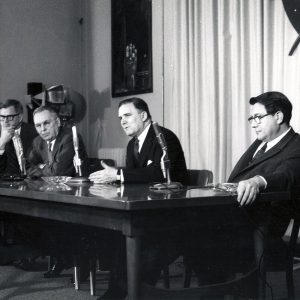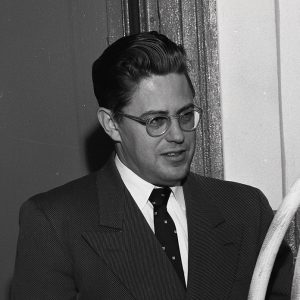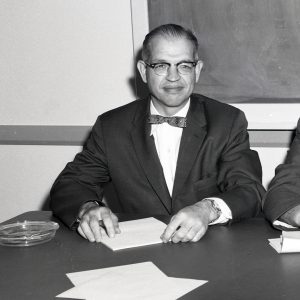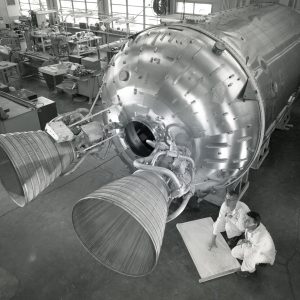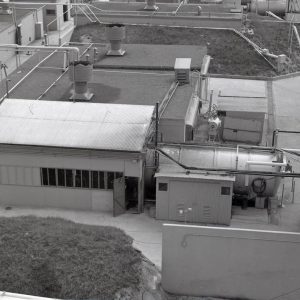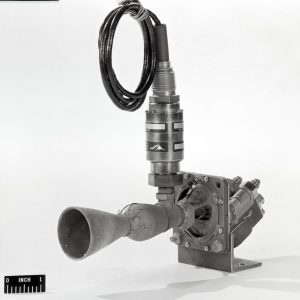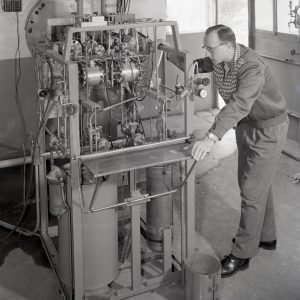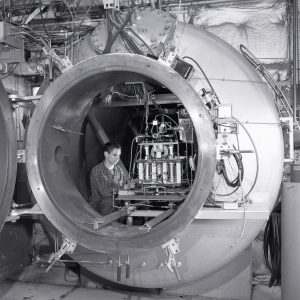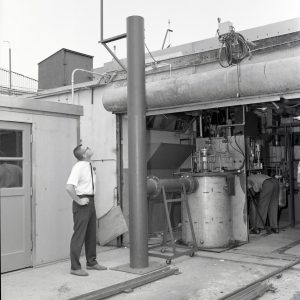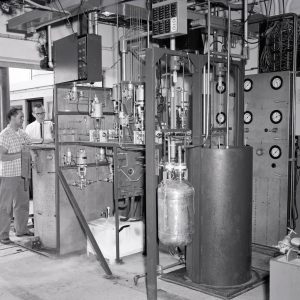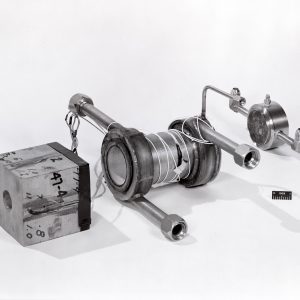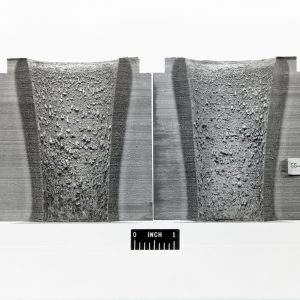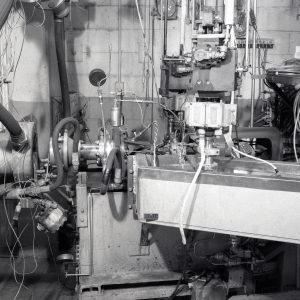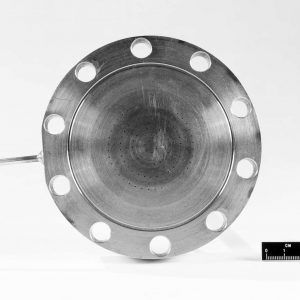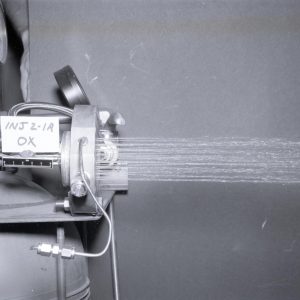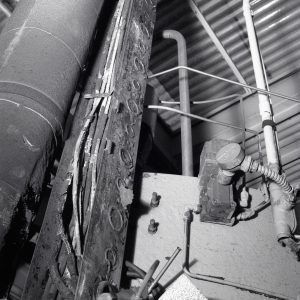Space Propulsion
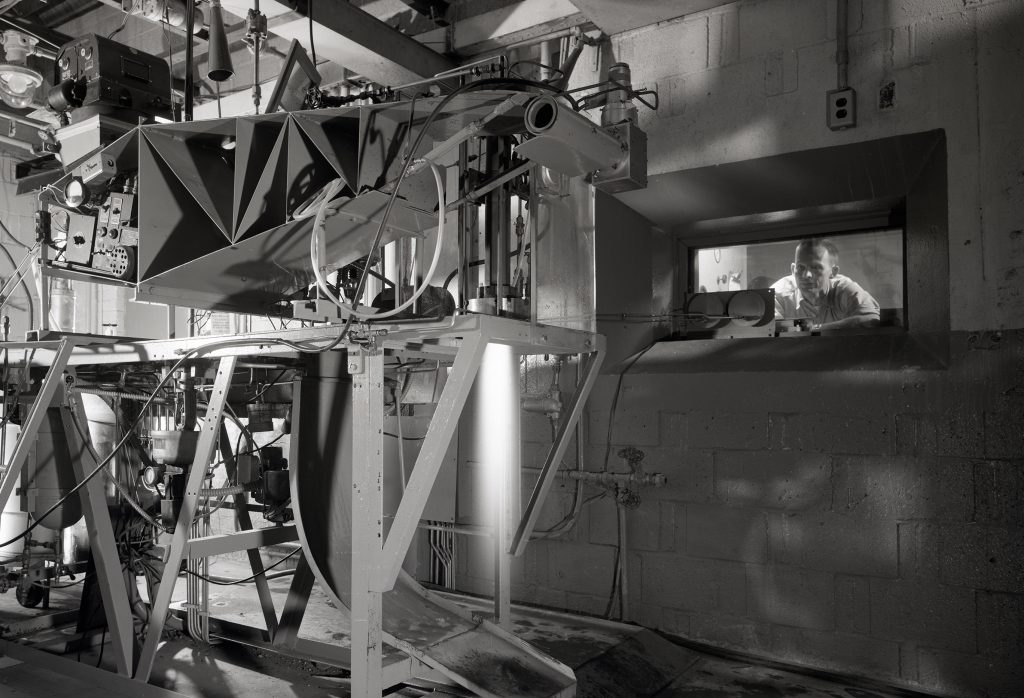
Overview
In 1958, the United States established a civilian space program in response to the Soviet Union’s launch of its Sputnik satellites in the fall of 1957. In October 1958, the Cleveland laboratory became part of the new National Aeronautics and Space Administration (NASA) and was renamed the Lewis Research Center. The center underwent a massive transformation over the next few years to refocus all of its resources on the space program.
The Rocket Laboratory’s evaluation of high-energy propellants wound down in the late 1950s and early 1960s as NASA settled on the liquid hydrogen and liquid oxygen combination for its upper-stage rockets. Lewis researchers continued to use the Rocket Lab to investigate combustion instability, laminar flow, ablative cooling, and small thrusters. The latter two fields would become recurring areas of Rocket Lab testing over the years.
Rocket Lab Impact on Apollo
Liquid hydrogen became a key element of NASA’S Apollo Program, fueling the upper stages from the Saturn and Atlas-Centaur launch vehicles. Lewis’ propellant testing in the 1950s, much of which was done at the Rocket Lab, was a critical contributor to NASA’s decisions in 1958 and 1959 to use the hydrogen-oxygen combination in its new launch systems.
Representatives from Pratt & Whitney and Rocketdyne, the manufacturers of the first hydrogen-powered engines, had visited the Rocket Lab multiple times in the late 1950s. In addition, Lewis personnel intimately familiar with the Rocket Lab activities, including Abe Silverstein, John Sloop, Adelbert Tischler, and Eldon Hall, transferred to Headquarters to manage aspects of the new space program. In 1959, Silverstein led another team responsible for selecting the upper stages for the Saturn booster. This group, referred to as the “Silverstein Committee,” again stated that only vehicles using high-energy propellants (liquid hydrogen) would be practical. Liquid hydrogen was also the propellant for the proposed nuclear rocket program.
With the agency’s selection of the liquid hydrogen-liquid oxygen propellant combination, the center’s rocket work shifted away from propellant evaluation to improving combustion, pumping systems, and storage of cryogenic fluids. By this point, there was little room at the crowded campus for additional rocket facilities, so another cluster of small rocket test cells was built at a remote facility in Sandusky. The Rocket Lab remained active testing new types of propulsion systems.
Mercury Capsule Thrusters
Most spacecraft and satellites require secondary propulsion systems to accurately attain and maintain their proper position in space. In 1959, the Rocket Lab began a decades-long study of various small, low-power thrusters and associated propellants. The initial testing was in support of NASA’s first human space missions, Project Mercury. Cell 24B’s altitude tank was used to test three commercially-produced hydrogen peroxide thrusters that were used to control the Mercury capsule’s alignment and attitude in space. Mission planners needed to be confident that the thrusters would ignite quickly when fired to maintain proper orbital position and alignment during reentry without excess fuel consumption. The testing in Cell 24B produced data on the start times as the temperature of the propellant and catalyst bed decreased.
As spacecraft became larger in the mid-1960s, they required more accurate positioning and trajectories. Spacecraft designers began investigating liquid-fueled thrusters to improve thruster power without increasing their size. Precision can be increased by shortening the impulse firing time. In 1965, researchers found that 1- and 5-pound nitrogen tetroxide-–hydrazine-type thrusters tested at simulated altitudes in Cell 24B produced equal performance efficiency. Follow up testing with four smaller thrusters, however, revealed that blockages in the tiny injector passages decreased performance.
NASA engineers also explored the use of water-electrolysis to power reaction control thrusters. The electrolysis of water during flight generates hydrogen and oxygen to serve as propellants or for fuel cells. The electrolysis system required gas storage tanks, a gas generator, ignition device, and thruster. Significant ignition problems and detonations in the flow line were observed during testing of the experimental system in Cell 24B. The concept was deemed too technologically complex at the time, but it has been revisited in the 1990s and 2000s for deep space missions.
Documents
- Temperature Effector on Thrust Buildup in Hydrogen Peroxide Rockets (1960)
- Performance of Bipropellant Fractional-Pound Thrusters (1968)
- Performance of a Water-Electrolysis Rocket (1969)
Low-Cost Engine Cooling
Cooling is an essential aspect of rocket engine design. Rockets operate more efficiently at higher temperatures, but the high temperatures damage engine components such as the thrust chamber and nozzle without some form of cooling. Larger engines often employ regenerative cooling that uses the cryogenic fuel as a coolant. A simpler, less expensive alternative is ablative cooling, which uses low-cost materials to line thrust chambers or nozzles. The materials intentionally burn up during engine operation providing protection to the components underneath.
Lewis researchers mounted a wide effort in the 1960s and 1970s to develop standards for ablatives that considered different materials, propellant combinations, thrust levels, and the use of throat inserts. The throat insert performance depended on the ability of materials to interact with combustion products, withstand melting and oxidation, and resist structural failure.
In the mid-1960s, Cell 21 was used for a series of tests of different ablative materials for throat section inserts. Lewis researchers first used the facility to analyze dozens of different materials in an engine with a 1.2-inch-diameter throat. In the summer of 1966, the 18 most promising materials were tested again in Cell 21 to determine optimum resins, reinforcements, and geometric variables. Testing of ablative materials continued in engines with larger diameter throats.
It was later reported that these studies led to “the addition of advanced ablative materials allowed for increased engine performance and a corresponding increased payload capacity, resulting in the ability to carry the lunar rover vehicle.”
Documents
- Materials Research Talk at 1966 Inspection
- Evaluation of Ablative Materials as Nozzle Sections (1966)
- Evaluation of Ablative Materials as Nozzle Sections (1969)
Propane for Long-Duration Missions
While the decision to proceed with liquid hydrogen-liquid oxygen was fast-tracked in the late 1950s, mission planners were also looking at future missions that would require greater payloads, flexibility, and velocity. Engineers saw the potential of a fluorine and oxygen combination (FLOX) as an oxidizer. FLOX was not only hypergolic, but also produced higher specific impulses than either oxygen or fluorine alone. Lewis had explored the use of FLOX as an oxidizer with JP-4 fuel in the mid-1950s.
A decade later, they sought to determine the effectiveness of FLOX when paired with liquified petroleum gases (LPGs). Methane was the most promising of the LPGs, but engineers considered propane better for long-duration missions. Lewis undertook efforts to design and test an ablatively cooled propane/FLOX engine with various ablative materials. In September 1968, Lewis researchers evaluated six injectors and three thrust chambers with different ablative materials on a 1,000-pound-thrust propane/FLOX engine in Cell 22. They also used the cell to operate the engine for 200 seconds, which was considered long-duration operation.
Documents
- Design and Testing of 1000-pound Thrust FLOX-Propane Ablative Engine (1969)
- Design of Injectors and Ablative Chambers for FLOX-Propane Engine (1969)

